The Champions League has returned with its second matchday of the group stage. The first series of matches took place on Tuesday evening and it ended up with many interesting results. And one of the mouth-watering matches that caught the eyes of many fans was between Serie A champion Juventus and German club Bayer 04 Leverkusen.
Both Juventus and Leverkusen were still looking for their first three points of the competition. But the Italian side secured a more positive result against a tougher opponent in Atlético Madrid with a 2-2 draw, while Leverkusen fell short when they welcomed Lokomotiv Moscow. Ultimately, three goals from Gonzalo Higuaín, Cristiano Ronaldo and Federico Bernardeschi brought Maurizio Sarri’s side their first win to help them moved top of their group.
This tactical analysis will provide an analysis of Juventus’ 3-0 win over Bayer Leverkusen. Meanwhile, using statistics, we will point out what went wrong for Peter Bosz’s tactics over Maurizio Sarri’s tactics.
Lineups
The former Chelsea manager opted to go for a 4-3-1-2 formation for their match that they welcomed Leverkusen. With both defenders Giorgio Chiellini and Mattia De Sciglio remained on the sidelines for an extended period, Sarri went for two familiar faces in Leonardo Bonucci and Juan Cuadrado.
Emre Can and Mario Mandžukić were left out of Juventus’ squad at the start of the season, and therefore, became ineligible for the match. Still, Sarri was left with the choice between Aaron Ramsey, Sami Khedira and Blaise Matuidi for the central midfielder’s spot alongside Miralem Pjanić. Furthermore, he also went for the option of pairing Gonzalo Higuaín with Cristiano Ronaldo up front as Paulo Dybala was on the bench.
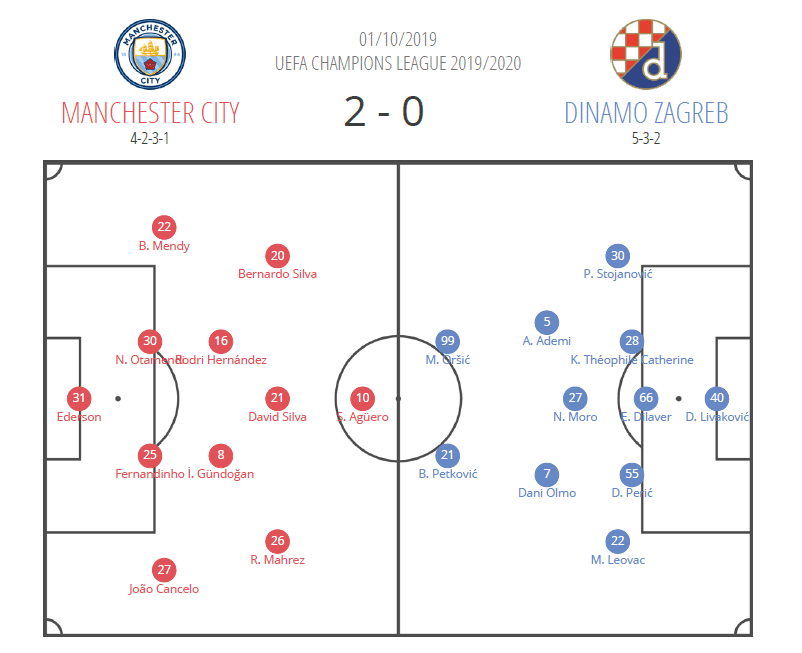
On the other hand, Bosz felt like the 4-1-2-3 formation would be a perfect fit for Leverkusen in this match. Leon Bailey was surely absented from the match due to his muscle injury as captain Kevin Volland filled in his left-winger position. Another winger also missed out from the match was Karim Bellarabi due to his illness.
At the heart of Leverkusen’s defence, Sven Bender paired up alongside Jonathan Tah while his twin brother Lars Bender wasn’t registered for their trip to Italy through a thigh injury. Nonetheless, Bosz still had two decent centre-backs in Aleksandar Dragović and Panagiotis Retsos on the bench, alongside three new signings in Nadiem Amiri, Daley Sinkgraven and Moussa Diaby.
Leverkusen’s style of play
Quite different from what they intended to line up at the start of the game, Leverkusen employed a 4-2-3-1 defensive shape when they were out of possession. They tended to raise their shape high up the pitch and positioned itself inside the middle third. Their aim was to create an overload in that area and forced Juventus to circulate the ball in their half during most of the time.
They pressed the opponent inside the middle half, as their aim was to win the ball and created counter-attacks. Based on the numbers of challenges (148) that they made, it’s fair to say that they have got what they want. It was also one of the factors that contributed to Leverkusen’s domination on ball possession (51%).
About the positioning of the players, Kerim Demirbay would join the midfielders and created a midfield three along with Volland and Kai Havertz. They supported striker Lucas Alario in the team’s press while screening the space between them and two central midfielders. At the same time, they had the option of moving flexibly depending on the situation as they could create a 4-4-1-1 formation with two clear defensive lines.
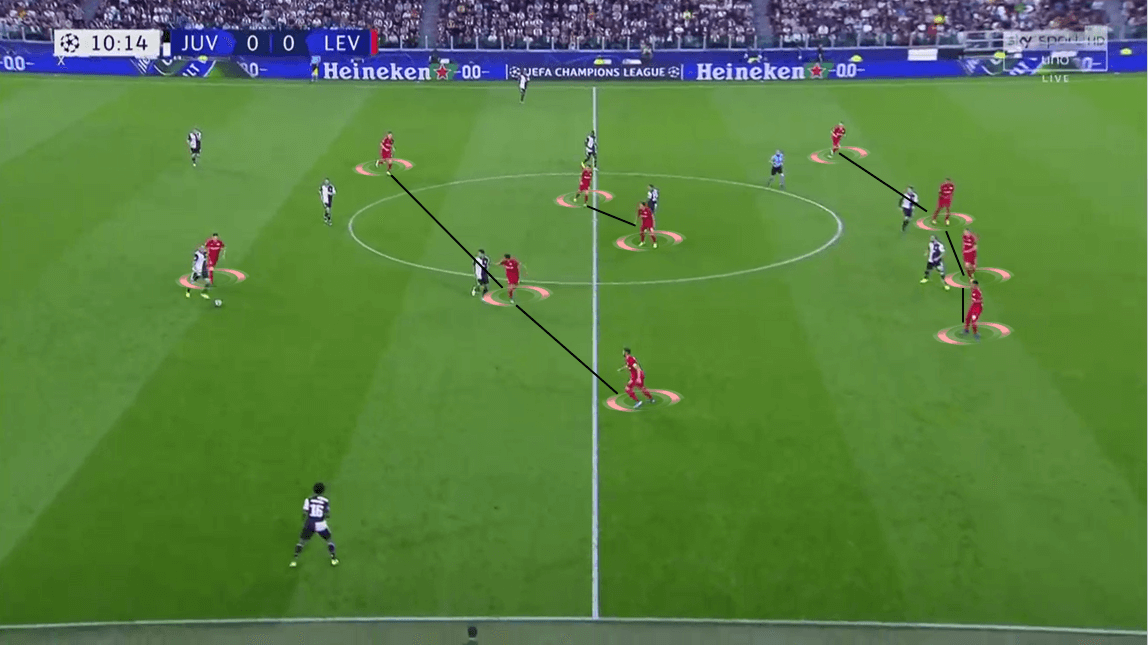
As four attackers attempted to disrupt Juventus’ build-up, the defensive line below usually stayed more compact inside the central half of the pitch. With both Ronaldo and Higuaín tended to sit on the shoulders of defenders, it was crucial for them to track the strikers’ run and be there to stop them.
In Tah and Bender, Leverkusen had two centre-backs who had the pace to either move out of position and tackled the ball or tracked back to cover for their teammates. Against two top quality strikers, they have had an average day with some decent moves to intercept passes. But at the same time, Leverkusen’s centre-backs also had some errors which led to dangerous attacks. One of them was eventually converted into a goal by Higuaín to give Juventus the early advantage.
In the shot below, notice the Argentinian striker’s positioning as he stayed close to Tah and waited for the ball to sprint towards the box. Indeed, as Cuadrado received the pass from Ronaldo, he noticed Higuaín’s run and sent a long ball towards it. As expected, Tah would use his physicality and pace to track the ball’s direction and outjumped Higuaín to clear the ball. Unfortunately, his clearance wasn’t effective as the ball fell towards the striker and a decisive shot towards the bottom left corner was enough to beat Lukáš Hrádecký.
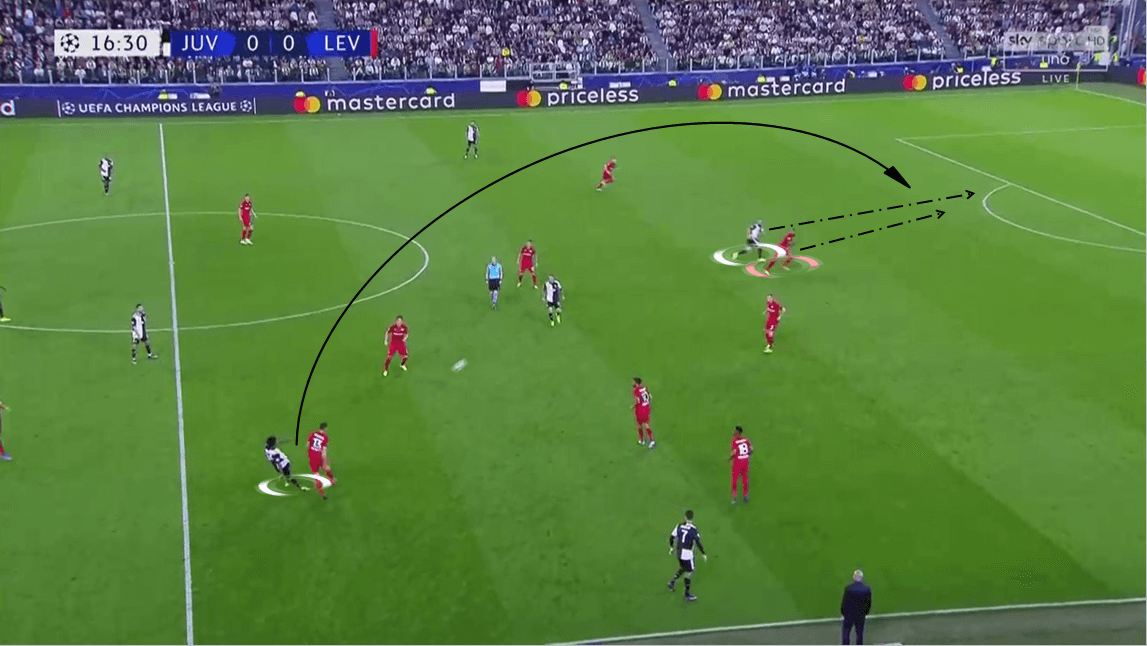
Another method which the team used to win the ball back was to create overloads in certain areas of the pitch. Wherever the ball went, their shape shifted along with it and allowed Leverkusen to have numbers in overloading the area surrounded the ball carrier. This forced him to either make a back pass and restart the team’s attack or shifting the attacking direction using a long pass towards the other side of the pitch.
Juventus were in this type of situation occasionally as the visitors were quick to transition their defensive structure across to swarm the space around the ball carrier. But, at times, the away side forgot about the possible passing options outside of the overloaded area. In both the situations above and below, Higuaín and Cuadrado were left with free space respectively. They were able to receive the lofted pass from the ball carrier and continued the team’s attack.
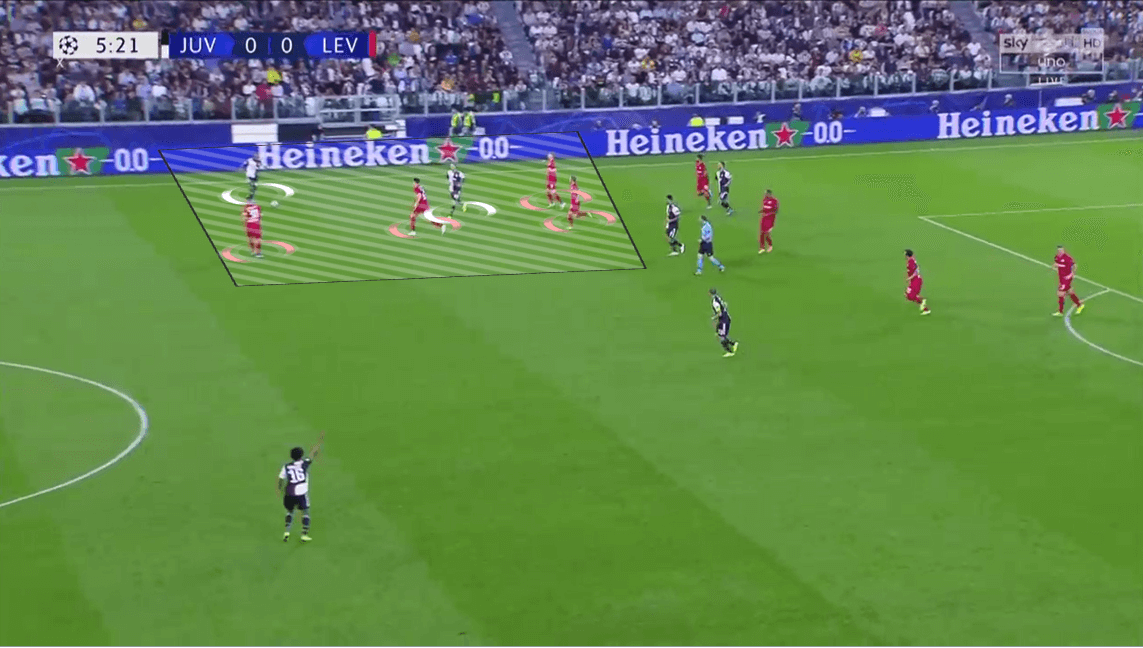
High up the pitch, they employed a man-oriented press which included the involvement of four attackers. Their task was to close down the ball carrier and every potential receiver around him, forcing him to clear the ball out. On several occasions, even both central midfielders Julian Baumgartlinger and Charles Aránguiz could join the press when Matuidi or Khedira opted to drop deep.
More noticeably on the image, most of Leverkusen players were in a more active state compared to Juventus’ players. They positioned themselves in front of the player that they were marking while keeping them in their sight. This eliminated the option of making short passes and combinations to bypass the press. At the same time, their high-intensity press could also result in heavy touches and misplaced passes. With the positioning of the players, Leverkusen were able to capitalise on it and created quick counter-attacks even inside the final third. Unfortunately, it didn’t work out for them as Juventus players were comfortable of holding the ball and it was hard to lure the ball away from their feet.
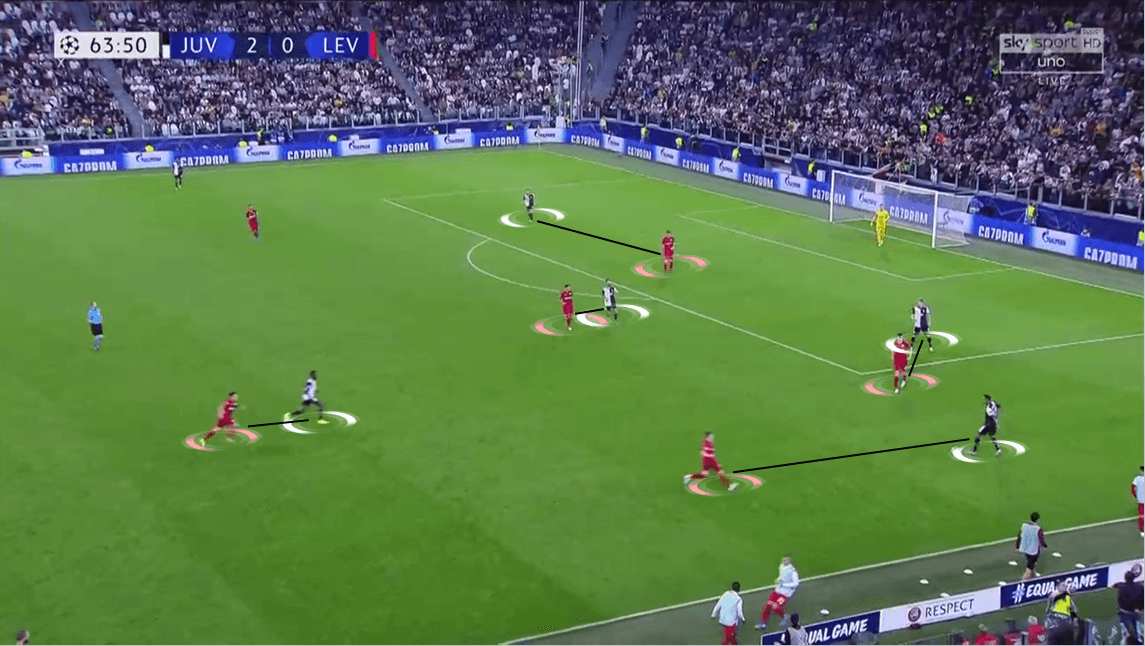
During the press, there were occasions that Leverkusen didn’t have enough players to cope with Juventus’ defenders. That was why they attempted to switch their formation to a 4-2-4 with Alario dropped deep and Havertz tucked inside. In the role of a false nine, the former River Plate striker usually stayed close to the midfielders and even pushed Demirbay towards the left-hand side.
In Leverkusen’s attacks, they also used a similar formation. Since Weiser constantly made overlapping runs up the pitch, Havertz had to tuck inside to create space for the right-back. Furthermore, since he was more comfortable as an attacking midfielder, it’s quite understandable for him to operate inside the half-space more than he would have inside the right flank.
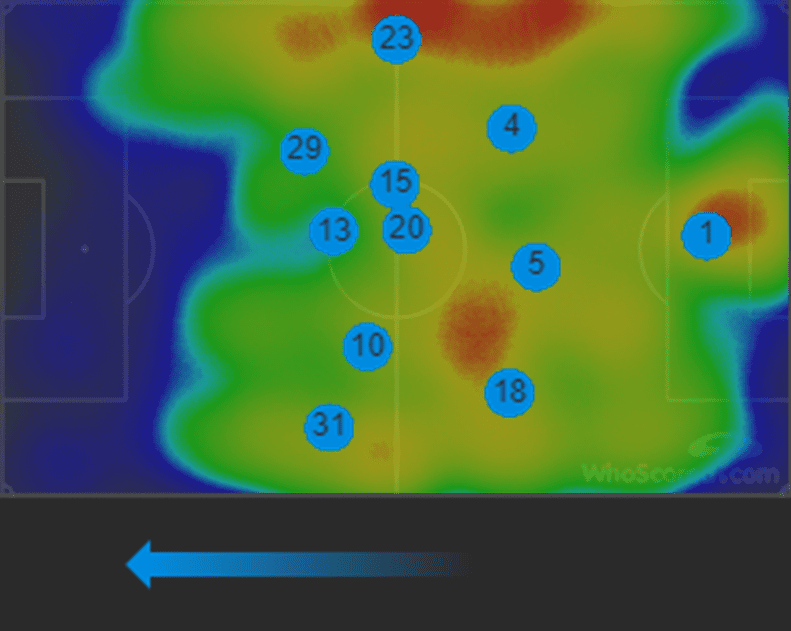
In possession, Leverkusen attempted to build attacks from the back using a 3-2-4-1 formation. The players divided the team into two groups of five players with different responsibilities. One would involve in the build-up and the other positioned themselves inside the opposite half. Combined with the fact that Juventus usually played with a high defensive line, this helped them to prevent the home side from winning numerical superiority.
Left-back Wendell Borges usually joined up with two centre-backs and his colleagues would move horizontally to form a three-man defence. Meanwhile, Mitchell Weiser on the opposite side tended to move high up the pitch and created a midfield four in between Juventus’ defensive lines. As the former Hertha Berlin defender is an attacking full-back, the fact that he went for the mentioned option wasn’t surprised. He has the pace to beat his man and would be able to pick up the ball for a sprint towards the final third. With the attacking productivity that he has, Bosz wouldn’t want to restrain Weiser inside the middle third.
By utilising the passing ability of Tah and Bender, they were able to shorten the build-up time. The central defenders would play a penetrative pass towards the attacking midfielder and signalling his teammates to move into pockets of space. They also had a second choice, making a short pass towards Baumgartlinger and Aránguiz. This season, we usually saw the Chilean midfielder dribbled the ball up the pitch to link up the two groups. By doing so, he would drag along some of the opposition’s players and creating spaces for his teammates to move in.
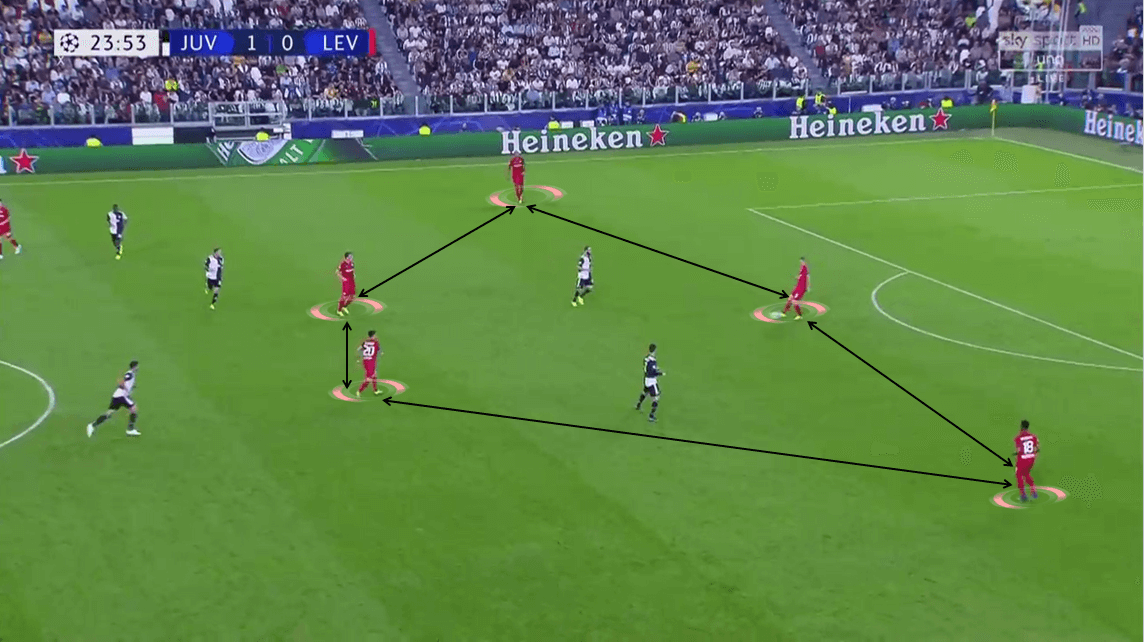
By avoiding high-density areas that Juventus created inside their half, it was capable for them to keep possession at a higher rate. Along with an asymmetric midfield box of two central midfielders and two attacking midfielders (Kai Havertz and Demirbay), they were able to create more links in between the players for progressing the ball up the pitch. Another noticeable point from Leverkusen’s build-up was the centre-backs tended to slow the ball down after they received it. It attracted the attention of the opposition’s player and would create spaces behind their back.
Juventus’ style of play
Being the more superior team in this match, it’s no surprise to see Juventus created more chances towards Leverkusen’s goal. With a total of eleven shots in which seven of them found the target, they reached a high-efficiency rate and the strikers capitalised on it to score three goals.
The fact that some of their chances were low-rated in xG contributed to Juventus’ 1.16 total xG rating. Nonetheless, they were able to outperform the xG numbers by having two goals more than what was expected from them.
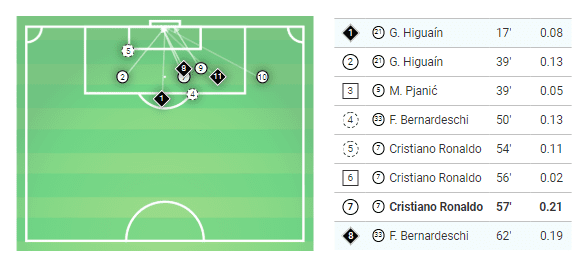
During the match, Juventus created their attacks by making the most out of their players’ movements. In most of their occasions, they would stay conservative and were happy to circulate the ball among themselves. This lured the opposition’s players out of their positions and created spaces behind their backs.
The shot below was one of the examples of the mentioned situation. When Pjanić dribbled the ball up to the middle third, he dragged Aránguiz and Bender out of their respective positions. Meanwhile, both Demirbay and Wendell put their attention towards Cuadrado as they thought the Colombian player would receive the ball. Instead, the Bosnian international noticed Bernardeschi attempted to attack from deep into the space that Bender and Wendell left behind. He picked out the former Fiorentina player with a through ball but found himself being chased by Tah and intercepted the ball later on.
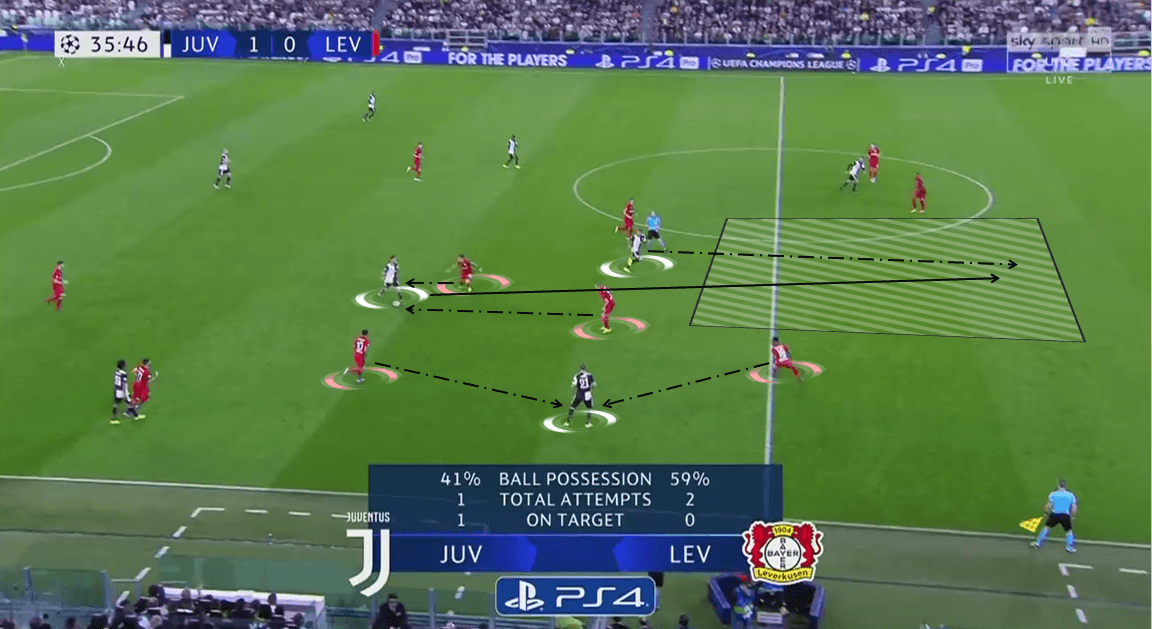
The Italian side also put an emphasis on their build-up using the ability of Mathijs de Ligt and Bonucci. As these two were able to play as ball-playing defenders, they took on the responsibility of holding more of the ball during the process and made penetrative passes.
Also, with three central midfielders occasionally dropped deep during the process, Juventus were able to create at least five passing triangles to circulate the ball among themselves. It also helped them in bypassing Leverkusen’s press which tended to be quite aggressive. The efficiency rate was also kept at a high level due to the fact that they had numbers during the process, which allowed the ball carrier to have more passing options to progress the ball up the pitch.
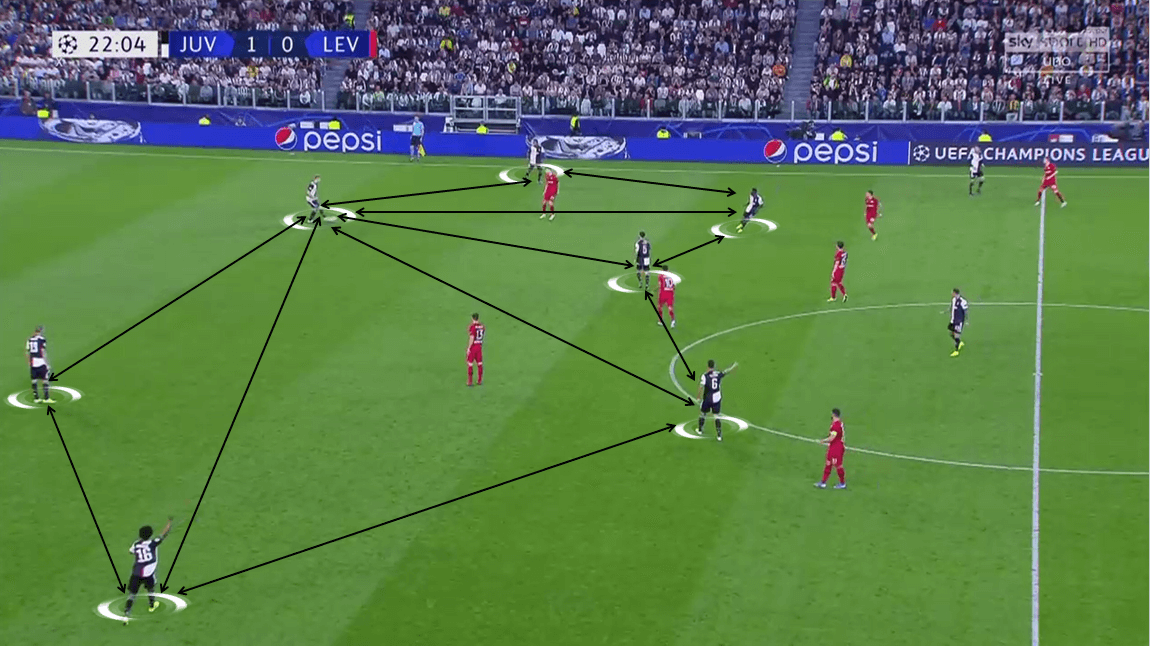
Defensively, they formed a 4-3-1-2 defensive shape in which three central midfielders would screen the space in front of themselves and the defensive line. They tended to stretch wide to occupy both the wide areas and the central half of the pitch, with the aim of preventing Leverkusen from distributing the ball towards both flanks.
Also, along with the fact that they usually push the defensive line fairly high, the intention of swarming the middle third was quite clear. Four defenders would position themselves on the edge of their defensive third and were ready to clear any long balls that came towards them. Meanwhile, the outside central midfielders would combine with one of the strikers to overload the flank where Leverkusen intended to progress the ball. They also became the focal point for the team to shift laterally across the pitch and started the press early on that side.
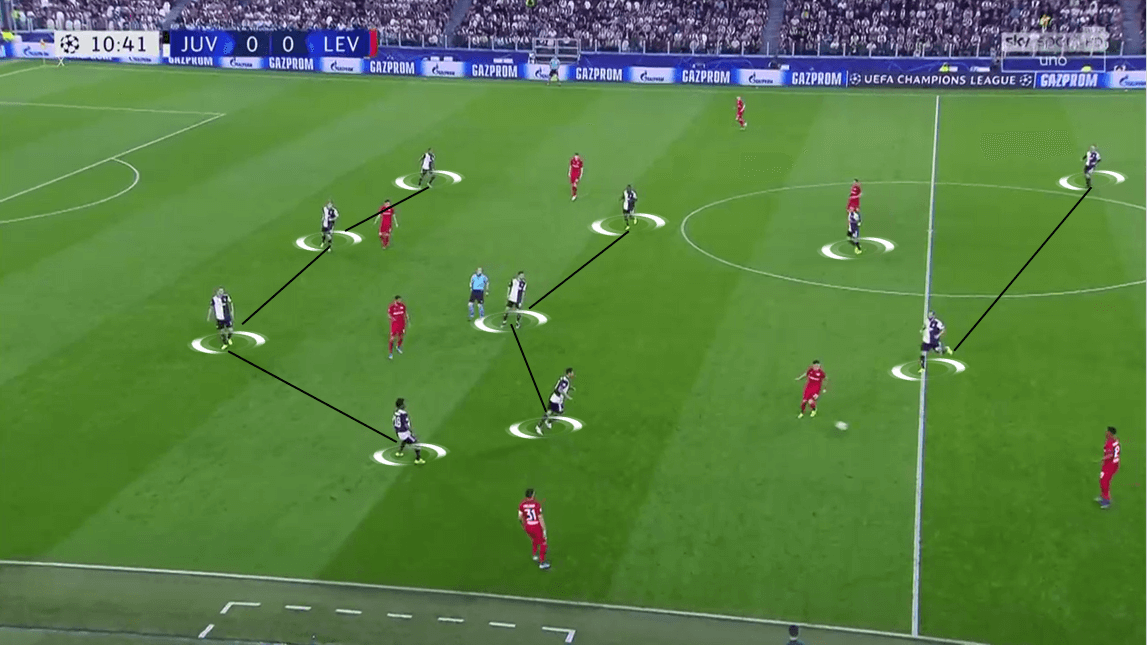
In order to win the ball inside Leverkusen’s half, Juventus employed a high press and aimed to disrupt the visitors’ build-up. Ronaldo and Higuaín would be the first players to apply pressure as they followed the centre-backs tightly. With both Tah and Bender opted to stay deep and received the ball from Hrádecký, they also moved close along with the intention of intercepting passes inside the final third.
Meanwhile, attacking midfielder Bernardeschi had more room to roam and marked the central midfielder. But he seemed like quite unnecessary as Juventus’ three central midfielders also moved up and eliminated the influence that Baumgartlinger, Aránguiz and Demirbay had on the build-up. Still, he took on the role of supporting both lines in case any of Leverkusen players decided to drop out from his position and provided a passing option.
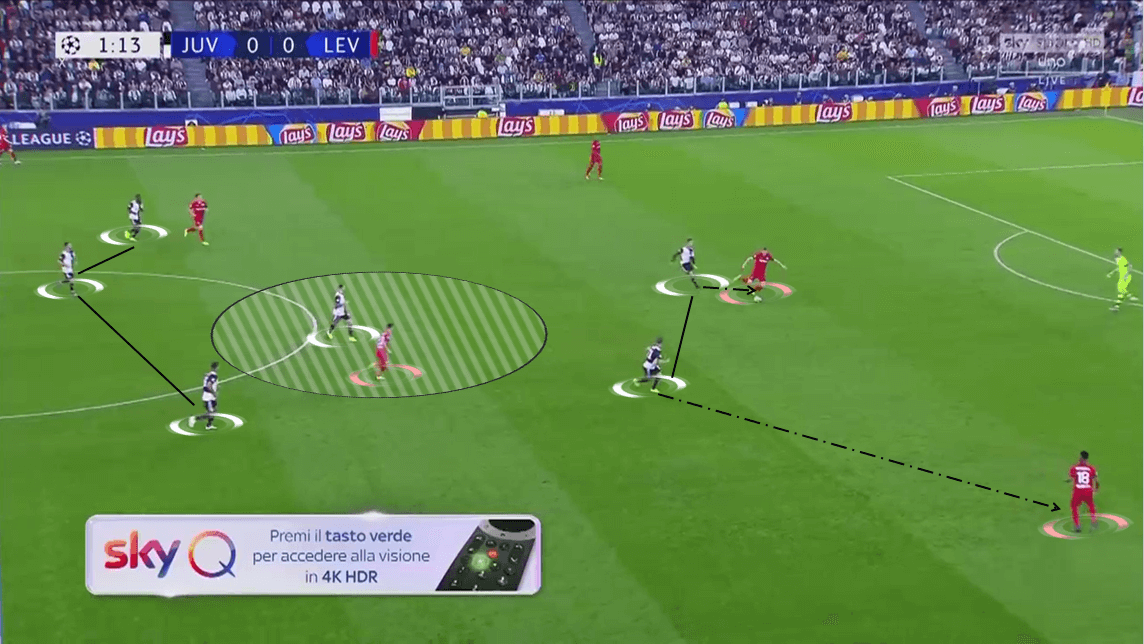
Conclusion
It’s no surprise to see the better team came out on top from this match, which was the case for Juventus. They had three goals that were scored in a comfortable way while capitalising the errors that the visitors showed throughout the game. In defence, the Italian side remained solid in front of their goal and prevented Leverkusen from making any significant chances towards Wojciech Szczesny’s goal.
On the tactical perspective, though, it was a very interesting match as Bosz’s side didn’t have such a terrible match. They were able to perform what they intended which allowed them to approach the 16-yard box on several occasions. But the only thing that they were lacking was the quality in both defence and attack. Some fans might say Leverkusen deserved something from the match, and indeed, with the tactical points that they have shown on the night, the result could have been better for them.

If you love tactical analysis, then you’ll love the digital magazines from totalfootballanalysis.com – a guaranteed 100+ pages of pure tactical analysis covering topics from the Premier League, Serie A, La Liga, Bundesliga and many, many more. Buy your copy of the September issue for just ₤4.99 here





Comments